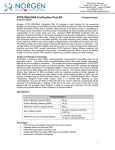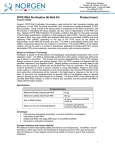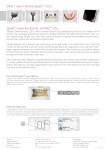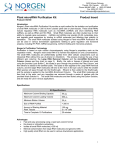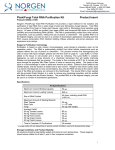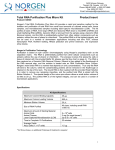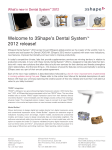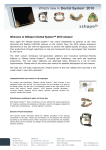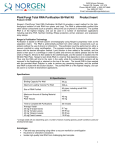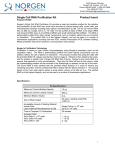Download User Manual
Transcript
3430 Schmon Parkway Thorold, ON, Canada L2V 4Y6 Phone: (905) 227-8848 Fax: (905) 227-1061 Email: [email protected] FFPE RNA Purification Kit Dx Product Insert Dx25300 PIDx25300-2 Intended Use Norgen’s FFPE RNA Purification Kit Dx provides a rapid method for the isolation and purification of total RNA (including microRNA) from formalin-fixed paraffin-embedded (FFPE) tissue samples subsequent in vitro diagnostic use. Using formalin to fix tissues leads to crosslinking of the RNA and proteins, and the process of embedding the tissue samples can also lead to fragmentation of the RNA over time. Norgen’s FFPE RNA Purification Kit Dx provides conditions that allow for the partial reversing of the formalin modifications, resulting in a high quality and yield of RNA. The kit is able to purify all sizes of RNA, from large mRNA and ribosomal RNA down to microRNA (miRNA) and small interfering RNA (siRNA), depending on the age of the FFPE tissue as the degree of fragmentation of the RNA will increase over time. This kit is designed to be used with any downstream application employing enzymatic amplification or other enzymatic modifications of RNA followed by signal detection or amplification. Any diagnostic results generated using the RNA isolated with Norgen’s FFPE RNA Purification Kit Dx in conjunction with an in vitro diagnostic assay should be interpreted with regard to other clinical or laboratory findings. To minimize irregularities in diagnostic results, suitable controls for downstream applications should be used. Norgen’s FFPE RNA Purification Kit Dx is intended for use by professional users such as technicians, physicians and biologists experienced and trained in molecular biological techniques. Norgen’s FFPE RNA Purification Kit Dx does not provide a diagnostic result. It is the sole responsibility of the user to use and validate the kit in conjunction with a downstream in vitro diagnostic assay. Kit Components Component Digestion Buffer Binding Solution Enzyme Incubation Buffer Wash Solution Elution Solution Proteinase K DNase I Micro Spin Columns Collection Tubes Elution tubes (1.7 mL) Product Insert Product # 25300 (50 preps) 20 mL 20 mL 6 mL 22 mL 6 mL 12 mg 200 µL 50 50 50 1 Label Legend Do not reuse Made in Canada Norgen Biotek Use by Batch Code Catalogue Number Contains sufficient for <n> tests Manufacturer In Vitro Diagnostic Medical Device Consult instructions for use Temperature limitation 1 Advantages • CE-IVD marked in accordance with EU Directive 98/79/EC • Fits into in vitro diagnostic workflows • Fast and easy processing using rapid spin-column format • Isolate total RNA, from large rRNA down to microRNA (miRNA) • No phenol or chloroform extractions Specifications Kit Specifications Maximum Column Binding Capacity (RNA) 50 µg Maximum Column Loading Volume 650 µL Size of RNA Purified All sizes, including small RNA (<200 nt) Maximum Amount of Starting Material 5 sections <20 µM thick 25 mg of unsectioned block Storage Conditions and Product Stability The DNAse I and Proteinase K should be stored at -20°C upon arrival. All other solutions and kit components should be kept tightly sealed and stored at room temperature. All solutions and plastics can be used until the expiration date specified on their labels. Precautions Ensure that a suitable lab coat, disposable gloves and protective goggles are worn when working with chemicals. For more information, please consult the appropriate Material Safety Data Sheets (MSDSs). These are available as convenient PDF files online at www.norgenbiotek.com. The Binding Solution contains guanidinium salts, and should be handled with care. Guanidinium salts form highly reactive compounds when combined with bleach, thus care must be taken to properly dispose of any of these solutions Customer-Supplied Reagents and Equipment You must have the following in order to use the Total RNA Purification Kit Dx: • Benchtop microcentrifuge • 96 - 100% ethanol • Xylene, histological grade • β-mercaptoethanol (optional) Procedures All centrifugation steps are carried out in a benchtop microcentrifuge. Various speeds are required for different steps, so please check your microcentrifuge specifications to ensure that it is capable of the proper speeds. All centrifugation steps are performed at room temperature. The correct rpm can be calculated using the formula: RPM = RCF (1.118 x 10-5) (r) where RCF = required gravitational acceleration (relative centrifugal force in units of g); r = radius of the rotor in cm; and RPM = the number of revolutions per minute required to achieve the necessary g-force. 2 Working with RNA RNases are very stable and robust enzymes that degrade RNA. Autoclaving solutions and glassware is not always sufficient to actively remove these enzymes. The first step when preparing to work with RNA is to create an RNase-free environment. The following precautions are recommended as your best defense against these enzymes. • The RNA area should be located away from microbiological work stations • Clean, disposable gloves should be worn at all times when handling reagents, samples, pipettes, disposable tubes, etc. It is recommended that gloves are changed frequently to avoid contamination • There should be designated solutions, tips, tubes, lab coats, pipettes, etc. for RNA only • All RNA solutions should be prepared using at least 0.05% DEPC-treated autoclaved water or molecular biology grade nuclease-free water • Clean all surfaces with commercially available RNase decontamination solutions • When working with purified RNA samples, ensure that they remain on ice during downstream applications Flow Chart Procedure for Purifying Total RNA using Norgen’s FFPE RNA Purification Kit Dx FFPE Tissue Samples Deparaffinization with xylene. Wash with ethanol Add Digestion Buffer, Proteinase K. Incubate. Add Binding Solution, Ethanol Bind RNA SPIN Wash RNA SPIN Elute RNA SPIN Purified Total RNA 3 Notes Prior to Use • All centrifugation steps are carried out in a benchtop microcentrifuge at 14,000 x g (~ 14,000 RPM) except where noted. All centrifugation steps are performed at room temperature. • A variable speed centrifuge should be used for maximum kit performance. If a variable speed centrifuge is not available a fixed speed centrifuge can be used, however reduced yields may be observed. • Ensure that all solutions are at room temperature prior to use. • All enzymes provided should remain at the storage temperature indicated on each vial until use. • Reconstitute the Proteinase K in 600 µL of molecular biology grade water, aliquot into small fractions and store the unused portions at -20°C until needed. • Prepare a working concentration of the Wash Solution by adding 50 mL of 96-100% ethanol (provided by the user) to the supplied bottle containing the concentrated Wash Solution. This will give a final volume of 72 mL. The label on the bottle has a box that may be checked to indicate that the ethanol has been added. • The maximum recommended input is five sections of < 20 µm thick. Alternatively, an unsectioned block of up to 25 mg may be used. • It is important to obtain sections from the interior of an FFPE block in order to minimize RNA damage by oxidation. • It is important to work quickly during this procedure. 1. Deparaffinization a. Cut sections up to 20 µm thick from the interior of an FFPE tissue block using a microtome. Trim off any excess paraffin. Note: Alternatively, from an FFPE block, cut out up to 25 mg of unsectioned core. Trim off any excess paraffin. Grind the sample into fine powder using liquid nitrogen. b. c. d. e. f. g. h. i. j. k. Transfer the sections or ground block into an RNase-free microcentrifuge tube. Add 1 mL of xylene to the sample. Mix by vortexing. o Incubate at 50 C for 5 minutes. Centrifuge the sample at 14,000 x g (~ 14,000 RPM) for 2 minutes. Carefully remove the xylene without dislodging the pellet. Add 1 mL of 95 - 100 % ethanol. Mix by vortexing. Centrifuge the sample at 14,000 x g (~ 14,000 RPM) for 2 minutes. Carefully remove the ethanol without dislodging the pellet. Repeat Step 1g to Step 1i for a second time. Air dry the pellet for about 10 minutes at room temperature. Note: It is important to remove the ethanol completely. l. Proceed to Step 2. Lysate Preparation 2. Lysate Preparation a. Add 300 µL of Digestion Buffer and 10 µL of the reconstituted Proteinase K to the sample. Mix by vortexing o o b. Incubate at 55 C for 15 minutes, followed by 80 C for 15 minutes. Vortex to mix occasionally. o Note: Do not exceed 15 minutes of incubation at 80 C as this will increase RNA fragmentation. c. Add 300 µL of Binding Solution. Vortex to mix. d. Add 600 µL of 96 – 100 % ethanol. Vortex to mix. 4 3. Binding RNA to Column a. Assemble a column with one of the provided collection tubes b. Apply up to 600 µL of the lysate with the ethanol (from Step 2) onto the column and centrifuge for 1 minute. c. Discard the flowthrough. Reassemble the spin column with its collection tube. d. Repeat Step 3b and 3c until all lysate has passed through the column. Optional Step: Norgen’s FFPE RNA Purification Kit isolates total RNA with minimal amounts of genomic DNA contamination. However, an optional On-Column DNA Removal Protocol is provided in Appendix A for maximum removal of residual DNA that may affect sensitive downstream applications. This step should be performed at this point in the protocol using the provided DNase I. 4. Column Wash a. Apply 400 µL of Wash Solution to the column and centrifuge for 1 minute. Note: Ensure the entire wash solution has passed through into the collection tube by inspecting the column. If the entire wash volume has not passed, spin for an additional minute. b. c. d. e. Discard the flowthrough and reassemble the spin column with its collection tube. Apply 400 µL of Wash Solution to the column and centrifuge for 1 minute. Discard the flowthrough and reassemble the spin column with its collection tube Wash column a third time by adding another 400 µL of Wash Solution and centrifuging for 1 minute. f. Discard the flowthrough and reassemble the spin column with its collection tube. g. Spin the column for 2 minutes in order to thoroughly dry the resin. Discard the collection tube. 5. RNA Elution a. Place the column into a fresh 1.7 mL Elution tube provided with the kit. b. Add 20 - 50 µL of Elution Solution to the column. Incubate the assembly at room temperature for 1 minute. c. Centrifuge for 2 minutes at 200 x g (~2,000 RPM), followed by a 1 minute spin at 14,000 x g (~14,000 RPM). Note the volume eluted from the column. If the entire volume has not been eluted, spin the column at 14,000 x g (~14,000 RPM) for 1 additional minute. Note: For maximum RNA recovery, it is recommended that a second elution be performed into a separate microcentrifuge tube (Repeat Steps 5b and 5c). 6. Storage of RNA The purified RNA may be stored at –20°C for a few days. It is recommended that samples be placed at –70°C for long term storage. 5 Appendix A Protocol for Optional On-Column DNA Removal Notes Prior to Use • This optional step is carried out if genomic DNA-free RNA is required. • Prepare a DNase I mixture by adding 4 µL of the provided RNase-free DNase I to 96 µL of Enzyme Incubation Buffer for each isolation. a. Apply 400 μL of Wash Solution to the column and centrifuge for 2 minutes. Discard the flowthrough. Note: Ensure the entire wash solution has passed through into the collection tube by inspecting the column. If the entire wash volume has not passed, spin for an additional minute. b. Apply 100 µL of Enzyme Incubation Buffer mix containing the RNase-free DNase I to the column and centrifuge at 14,000 x g (~14,000 RPM) for 1 minute. Note: Ensure that the entire volume of DNase I mix passes through the column. If needed, spin at 14,000 x g for an additional minute. c. After the centrifugation in Step b, pipette the flowthrough that is present in the collection tube back onto the top of the column. Note: Ensure that Step c is performed in order to ensure maximum DNase activity and to obtain maximum yields of RNA, in particular for small RNA species. d. Incubate at room temperature for 15 minutes. e. Proceed to Step 4c without further centrifugation. Technical Support Contact our Technical Support Team between the hours of 8:30 and 5:30 (Eastern Standard Time) at (905) 227-8848 or Toll Free at 1-866-667-4362. Technical support can also be obtained from our website (www.norgenbiotek.com) or through email at [email protected]. 6 Troubleshooting Guide Problem Poor RNA Recovery Clogged Column Possible Cause Solution and Explanation Incomplete lysis of cells or tissue Ensure that the appropriate amount of Digestion Buffer with Proteinase K added was used. Increase the incubation time. Column has become clogged Do not exceed the recommended amounts of starting materials. The amount of starting material may need to be decreased if the column shows clogging below the recommended levels. See also “Clogged Column” below. An alternative elution solution was used It is recommended that the Elution Solution supplied with this kit be used for maximum RNA recovery. Ethanol or Binding Solution was not added to the lysate Ensure that the appropriate amount of ethanol and Binding Solution are added to the lysate before binding to the column. Ethanol was not added to the Wash Solution Ensure that 50 mL of 96-100% ethanol is added to the supplied Wash Solution prior to use. Low RNA content in cells or tissues used Different tissues and cells have different RNA contents, and thus the expected yield of RNA will vary greatly from these different sources. Please check literature to determine the expected RNA content of your starting material. Insufficient solubilization of cells or tissues Ensure that the appropriate amount of lysis buffer was used for the amount of cells or tissue. Maximum number of cells or amount of tissue exceeds kit specifications Refer to specifications to determine if amount of starting material falls within kit specifications Clarified lysate was not used for the binding step Ensure that after the lysis step the sample is centrifuged if a significant amount of debris is present, and that only the clarified lysate is used in subsequent steps. Centrifuge temperature too low Ensure that the centrifuge remains at room temperature throughout the procedure. Temperatures below 15°C may cause precipitates to form that can cause the columns to clog. 7 Problem RNA is Degraded RNA does not perform well in downstream applications Possible Cause Solution and Explanation FFPE sample is old The quality of RNA purified may drastically decrease in old samples. For best performance, freshly prepared samples are highly recommended. RNase contamination RNases may be introduced during the use of the kit. Ensure proper procedures are followed when working with RNA. Please refer to “Working with RNA” at the beginning of this user guide. Procedure not performed quickly enough In order to maintain the integrity of the RNA, it is important that the procedure be performed quickly. This is especially important for the Cell Lysate Preparation Step in the Animal Tissue protocol, since the RNA in animal tissues is not protected after harvesting until it is disrupted and homogenized. Improper storage of the purified RNA For short term storage RNA samples may be stored at –20°C for a few days. It is recommended that samples be stored at –70°C for longer term storage. Prolonged o incubation at 80 C In order to reverse formalin crosslinks, an incubation at o 80 C is required. Do not exceed 15 minutes of incubation o at 80 C as this will increase RNA fragmentation. Starting material may have a high RNase content For starting materials with high RNAase content, it is recommended that β-mercaptoethanol be added to the Binding Solution. RNA was not washed 3 times with the provided Wash Solution Traces of salt from the binding step may remain in the sample if the column is not washed 3 times with Wash Solution. Salt may interfere with downstream applications, and thus must be washed from the column. Ethanol carryover Ensure that the dry spin under the Column Wash procedure is performed, in order to remove traces of ethanol prior to elution. Ethanol is known to interfere with many downstream applications. Formalin crosslink was not completely reversed Ensure the sufficient incubation at 80 C is performed in o Step 2b. Do not exceed 15 minutes of incubation at 80 C as this will increase RNA fragmentation. o 8 Product Use Restriction Norgen’s FFPE RNA Purification Kit Dx provides a rapid method for the isolation and purification of total RNA (including microRNA) from formalin-fixed paraffin-embedded (FFPE) tissue samples subsequent in vitro diagnostic use. This kit is designed to be used with any downstream application employing enzymatic amplification or other enzymatic modifications of RNA followed by signal detection or amplification. Any diagnostic results generated using the RNA isolated with Norgen’s FFPE RNA Purification Kit Dx in conjunction with an in vitro diagnostic assay should be interpreted with regard to other clinical or laboratory findings. To minimize irregularities in diagnostic results, suitable controls for downstream applications should be used. Norgen’s FFPE RNA Purification Kit Dx is intended for use by professional users such as technicians, physicians and biologists experienced and trained in molecular biological techniques. Norgen’s FFPE RNA Purification Kit Dx does not provide a diagnostic result. It is the sole responsibility of the user to use and validate the kit in conjunction with a downstream in vitro diagnostic assay. The respective user is liable for any and all damages resulting from application of Norgen’s FFPE RNA Purification Kit Dx for use deviating from the intended use as specified in the user manual. All products sold by Norgen Biotek are subjected to extensive quality control procedures and are warranted to perform as described when used correctly. Any problems should be reported immediately. The kit contents are for laboratory use only, and they must be stored in the laboratory and must not be used for purposes other than intended. The kit contents are unfit for consumption. Authorized Representative Norgen Biotek Corp. 3430 Schmon Parkway, Thorold, ON Canada L2V 4Y6 Phone: (905) 227-8848 Fax: (905) 227-1061 Toll Free in North America: 1-866-667-4362 ©2015 Norgen Biotek Corp. PIDx25300-2 9









